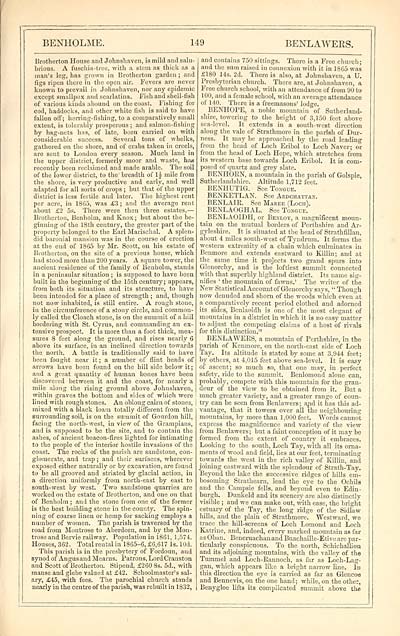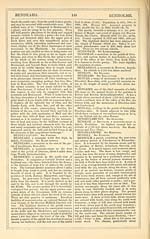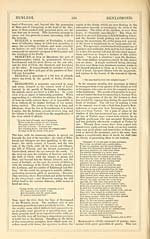Imperial gazeteer of Scotland, or, Dictionary of Scottish topography > Volume 1
(245) Page 149 - BEN
Download files
Complete book:
Individual page:
Thumbnail gallery: Grid view | List view

BENHOLME.
149
BENLAWERS.
Brotherton House and Jolinsliaven, is mild and salu-
brious. A fuBChia-tree, with a stem as thick as a
man's leg, has grown in Brotherton garden; and
figs ripen there in the open air. Fevers are never
known to prevail in Jolinsliaven, nor any epidemic
except smallpox and scarlatina. Fish and shell-fish
of various kinds abound on the coast. Fishing for
cod, haddocks, and other white fish is said to have
fallen off; herring-fishing, to a comparatively small
extent, is tolerably prosperous ; and salmon-fislung
by bag-nets has, of late, been carried on with
considerable success. Several tons of whelks,
gathered on the shore, and of crabs taken in creels,
are sent to London every season. Much land in
the upper district, formerly moor and waste, has
recently been reclaimed and made arable. The soil
of the lower district, to the breadth of 1A mile from
the shore, is veiy productive and early, and well
adapted for all sorts of crops ; but that of the upper
district is less fertile and later. The highest rent
per acre, in 1865, was £3 ; and the average rent
about £2 5s. There were then three estates, —
Brotherton, Benholm, and Knox; but about the be-
ginning of the 18th century, the greater part of the
property belonged to the Earl Marischal. A splen-
did baronial mansion was in the course of erection
at the end of 1865 by Mr. Seott, on his estate of
Brotherton, on the site of a previous house, which
had stood more than 200 years. A square tower, the
ancient residence of the family of Benholm, stands
in a peninsular situation ; is supposed to have been
built in the beginning of the loth century; appears,
from both its situation and its structure, to have
been intended for a place of strength ; and, though
not now inhabited, is still entire. A rough stone,
in the circumference of a stony circle, and common-
ly called the Cloaeh stone, is on the summit of a hill
bordering with St. Cyrus, and commanding an ex-
tensive prospect. It is more than a foot thick, mea-
sures 8 feet along the ground, and rises nearly 6
above its surface, in an inclined direction towards
the north. A battle is traditionally said to have
been fought near it ; a number of flint heads of
arrows have been found on the hill side below it;
and a great quantity of human bones have been
discovered between it and the coast, for nearly a
mile along the rising ground above Johnshaven,
within graves the bottom and sides of which were
lined with rough stones. An oblong cairn of stones, |
mixed with a black loam totally different from the
surrounding soil, is on the summit of Gonrdon hill,
facing the north-west, in view of the Grampians,
and is supposed to be the site, and to contain the
ashes, of ancient beacon-fires lighted for intimating
to the people of the interior hostile invasions of the
coast. The rocks of the parish are sandstone, con-
glomerate, and trap ; and their surfaces, wherever
exposed either naturally or by excavation, are found
to be all grooved and striated by glacial action, in
a direction uniformly from north-east by east to
south-west by west. Two sandstone quarries are
worked on the estate of Brotherton, and one on that
of Benholm ; and the stone from one of the former-
is the best building stone in the county. The spin-
ning of coarse linen or hemp for sacking employs a
number of women. The parish is traversed by the
road from Montrose to Aberdeen, and by the Mon-
trose and Bervie railway. Population in 1861, 1,574.
Houses, 362. Total rental in 1865-6, £6,617 Is. lOd.
This parish is in the presbytery of Fordoun, and
synod of Angusand Mearns. Patrons, Lord Cranston
and Scott of Brotherton. Stipend, £260 8s. 5d., with
manse and glebe valued at £42. Schoolmaster's sal-
ary, £45, with fees. The parochial church stands
nearly in the centre of the parish, was rebuilt in 1S32,
and contains 750 sittings. There is a Free church;
and the sum raised in connexion with it in 18G5 was
£180 14s. 2d. There is also, at Jolinsliaven, a U.
Presbyterian church. There are, at Jolinsliaven, a
Free church school, with an attendance of from 90 to
100, and a female school, with an average attendance
of 140. There is a freemasons' lodge.
BENHOPE, a noble mountain of Sutherland-
shire, towering to the height of 3,150 feet above
sea-level. It extends in a south-west direction
along the vale of Strathmore in the parish of Dur-
ness. It may be approached by the road leading
from the head of Loch Eribol to Loch Naver; or
from the head of Loch Hope, which stretches from
its western base towards Loch Eribol. It is com-
posed of quartz and grey slate.
BENHORN, a mountain in the parish of Golspie,
Sutherlandshire. Altitude 1,712 feet.
BENHUTIG. See Tongue.
BENKETLAN. See Ardchattan.
BENLAIR. See Makee (Loch).
BENLAOGHAL. See Tongue.
BENLAOIDH, or Benloy, a magnificent moun-
tain on the mutual borders of Perthshire and Ar-
gyleshire. It is situated at the head of Strathfillan,
about 4 miles south-west of Tyndrum. It forms the
western extremity of a chain which culminates in
Benmore and extends eastward to Killin; and at
the same time it projects two grand spurs into
Glenorchy, and is the loftiest summit connected
with that superbly highland district. Its name sig-
nifies ' the mountain of fawns.' The writer of the
New Statistical Account of Glenorchy says, " Though
now denuded and shorn of the woods which even at
a comparatively recent period clothed and adorned
its sides, Benlaoidh is one of the most elegant of
mountains in a district in which it is no easy matter
to adjust the competing claims of a host of rivals
for this distinction."
BENLAWEPvS, a mountain of Perthshire, in the
parish of Kenmore, on the north-east side of Loch
Tay. Its altitude is stated by some at 3,944 feet;
by others, at 4,015 feet above sea-level. It is easy
of ascent; so much so, that one may, in perfec't
safety, ride to the summit. Benlomond alone can,
probably, compete with this mountain for the gran-
deur of the view to be obtained from it. But a
much greater variety, and a greater range of coun-
try can be seen from Benlawers; and it has this ad-
vantage, that it towers over all the neighbouring
mountains, by more than 1,000 feet. Words cannot
express the magnificence and variety of the view
from Benlawers; but a faint conception of it may be
formed from the extent of country it embraces.
Looking to the south, Loch Tay, with all its orna-
ments of wood and field, lies at our feet, terminating
towards the west in the rich valley of Killin, and
joining eastward with the splendour of Strath- Tay.
Beyond the lake the successive ridges of hills em-
bosoming Stratheam, lead the eye to the Ochils
and the Campsie fells, and beyond even to Edin-
burgh. Dunkeld and its sceneiy are also distinctly
visible ; and we can make out, with ease, the bright
estuary of the Tay, the long ridge of the Sidlaw
lulls, and the plain of Strathmore. Westward, we
trace the hill-screens of Loch Lomond and Loch
Katrine, and, indeed, every marked mountain as far
asOban. Beneruachanand Buachaille-Etive are par-
ticularly conspicuous. To the north, Schichallion
and its adjoining mountains, with the valley of the
Tummel and Loeh-Eannoch, as far as Loch-Lag-
gan, which appears like a bright narrow line. In
this direction the eye is earned as far as Glencoe
and Bennevis, on the one hand ; while, on the other,
Benygloe lifts its complicated summit above the
149
BENLAWERS.
Brotherton House and Jolinsliaven, is mild and salu-
brious. A fuBChia-tree, with a stem as thick as a
man's leg, has grown in Brotherton garden; and
figs ripen there in the open air. Fevers are never
known to prevail in Jolinsliaven, nor any epidemic
except smallpox and scarlatina. Fish and shell-fish
of various kinds abound on the coast. Fishing for
cod, haddocks, and other white fish is said to have
fallen off; herring-fishing, to a comparatively small
extent, is tolerably prosperous ; and salmon-fislung
by bag-nets has, of late, been carried on with
considerable success. Several tons of whelks,
gathered on the shore, and of crabs taken in creels,
are sent to London every season. Much land in
the upper district, formerly moor and waste, has
recently been reclaimed and made arable. The soil
of the lower district, to the breadth of 1A mile from
the shore, is veiy productive and early, and well
adapted for all sorts of crops ; but that of the upper
district is less fertile and later. The highest rent
per acre, in 1865, was £3 ; and the average rent
about £2 5s. There were then three estates, —
Brotherton, Benholm, and Knox; but about the be-
ginning of the 18th century, the greater part of the
property belonged to the Earl Marischal. A splen-
did baronial mansion was in the course of erection
at the end of 1865 by Mr. Seott, on his estate of
Brotherton, on the site of a previous house, which
had stood more than 200 years. A square tower, the
ancient residence of the family of Benholm, stands
in a peninsular situation ; is supposed to have been
built in the beginning of the loth century; appears,
from both its situation and its structure, to have
been intended for a place of strength ; and, though
not now inhabited, is still entire. A rough stone,
in the circumference of a stony circle, and common-
ly called the Cloaeh stone, is on the summit of a hill
bordering with St. Cyrus, and commanding an ex-
tensive prospect. It is more than a foot thick, mea-
sures 8 feet along the ground, and rises nearly 6
above its surface, in an inclined direction towards
the north. A battle is traditionally said to have
been fought near it ; a number of flint heads of
arrows have been found on the hill side below it;
and a great quantity of human bones have been
discovered between it and the coast, for nearly a
mile along the rising ground above Johnshaven,
within graves the bottom and sides of which were
lined with rough stones. An oblong cairn of stones, |
mixed with a black loam totally different from the
surrounding soil, is on the summit of Gonrdon hill,
facing the north-west, in view of the Grampians,
and is supposed to be the site, and to contain the
ashes, of ancient beacon-fires lighted for intimating
to the people of the interior hostile invasions of the
coast. The rocks of the parish are sandstone, con-
glomerate, and trap ; and their surfaces, wherever
exposed either naturally or by excavation, are found
to be all grooved and striated by glacial action, in
a direction uniformly from north-east by east to
south-west by west. Two sandstone quarries are
worked on the estate of Brotherton, and one on that
of Benholm ; and the stone from one of the former-
is the best building stone in the county. The spin-
ning of coarse linen or hemp for sacking employs a
number of women. The parish is traversed by the
road from Montrose to Aberdeen, and by the Mon-
trose and Bervie railway. Population in 1861, 1,574.
Houses, 362. Total rental in 1865-6, £6,617 Is. lOd.
This parish is in the presbytery of Fordoun, and
synod of Angusand Mearns. Patrons, Lord Cranston
and Scott of Brotherton. Stipend, £260 8s. 5d., with
manse and glebe valued at £42. Schoolmaster's sal-
ary, £45, with fees. The parochial church stands
nearly in the centre of the parish, was rebuilt in 1S32,
and contains 750 sittings. There is a Free church;
and the sum raised in connexion with it in 18G5 was
£180 14s. 2d. There is also, at Jolinsliaven, a U.
Presbyterian church. There are, at Jolinsliaven, a
Free church school, with an attendance of from 90 to
100, and a female school, with an average attendance
of 140. There is a freemasons' lodge.
BENHOPE, a noble mountain of Sutherland-
shire, towering to the height of 3,150 feet above
sea-level. It extends in a south-west direction
along the vale of Strathmore in the parish of Dur-
ness. It may be approached by the road leading
from the head of Loch Eribol to Loch Naver; or
from the head of Loch Hope, which stretches from
its western base towards Loch Eribol. It is com-
posed of quartz and grey slate.
BENHORN, a mountain in the parish of Golspie,
Sutherlandshire. Altitude 1,712 feet.
BENHUTIG. See Tongue.
BENKETLAN. See Ardchattan.
BENLAIR. See Makee (Loch).
BENLAOGHAL. See Tongue.
BENLAOIDH, or Benloy, a magnificent moun-
tain on the mutual borders of Perthshire and Ar-
gyleshire. It is situated at the head of Strathfillan,
about 4 miles south-west of Tyndrum. It forms the
western extremity of a chain which culminates in
Benmore and extends eastward to Killin; and at
the same time it projects two grand spurs into
Glenorchy, and is the loftiest summit connected
with that superbly highland district. Its name sig-
nifies ' the mountain of fawns.' The writer of the
New Statistical Account of Glenorchy says, " Though
now denuded and shorn of the woods which even at
a comparatively recent period clothed and adorned
its sides, Benlaoidh is one of the most elegant of
mountains in a district in which it is no easy matter
to adjust the competing claims of a host of rivals
for this distinction."
BENLAWEPvS, a mountain of Perthshire, in the
parish of Kenmore, on the north-east side of Loch
Tay. Its altitude is stated by some at 3,944 feet;
by others, at 4,015 feet above sea-level. It is easy
of ascent; so much so, that one may, in perfec't
safety, ride to the summit. Benlomond alone can,
probably, compete with this mountain for the gran-
deur of the view to be obtained from it. But a
much greater variety, and a greater range of coun-
try can be seen from Benlawers; and it has this ad-
vantage, that it towers over all the neighbouring
mountains, by more than 1,000 feet. Words cannot
express the magnificence and variety of the view
from Benlawers; but a faint conception of it may be
formed from the extent of country it embraces.
Looking to the south, Loch Tay, with all its orna-
ments of wood and field, lies at our feet, terminating
towards the west in the rich valley of Killin, and
joining eastward with the splendour of Strath- Tay.
Beyond the lake the successive ridges of hills em-
bosoming Stratheam, lead the eye to the Ochils
and the Campsie fells, and beyond even to Edin-
burgh. Dunkeld and its sceneiy are also distinctly
visible ; and we can make out, with ease, the bright
estuary of the Tay, the long ridge of the Sidlaw
lulls, and the plain of Strathmore. Westward, we
trace the hill-screens of Loch Lomond and Loch
Katrine, and, indeed, every marked mountain as far
asOban. Beneruachanand Buachaille-Etive are par-
ticularly conspicuous. To the north, Schichallion
and its adjoining mountains, with the valley of the
Tummel and Loeh-Eannoch, as far as Loch-Lag-
gan, which appears like a bright narrow line. In
this direction the eye is earned as far as Glencoe
and Bennevis, on the one hand ; while, on the other,
Benygloe lifts its complicated summit above the
Set display mode to: Large image | Transcription
Images and transcriptions on this page, including medium image downloads, may be used under the Creative Commons Attribution 4.0 International Licence unless otherwise stated. ![]()
| Gazetteers of Scotland, 1803-1901 > Imperial gazeteer of Scotland, or, Dictionary of Scottish topography > Volume 1 > (245) Page 149 - BEN |
|---|
| Permanent URL | https://digital.nls.uk/97462070 |
|---|
| Description | Volume I: Aan-Gordon. |
|---|---|
| Attribution and copyright: |
|

